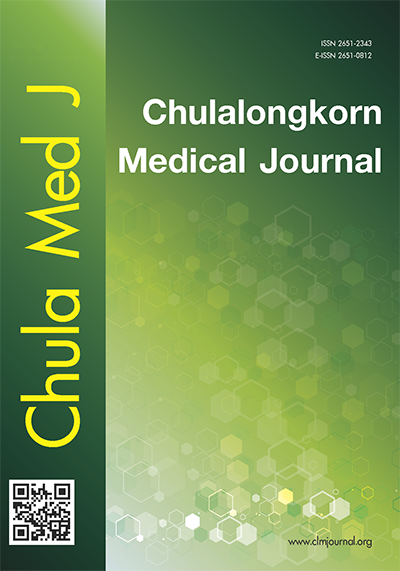Incidence and associated factors of negative appendectomy and ruptured appendicitis in PMSMC
Keywords:
Negative appendectomy, Acute appendicitis, Ruptured appendicitisAbstract
Introduction : Acute appendicitis is the most common acute surgical condition. Too early operation may reduce the chance of appendiceal perforation but increases negative appendectomy cases. These two outcomes must be weighted carefully before the surgical treatment is performed.
Objective : To find out negative appendectomy rate, perforation rate, and clinical factors associated with negative appendectomy and ruptured appendicitis in Princess Maha Chakri Sririndhorn Medical Center (PMSMC).
Setting : PMSMC tertiary care setting.
Study design : Retrospective descriptive study.
Patients : All patients who were diagnosed as acute appendicitis at PMSMC from 2003 to 2008. Incidental appendectomy, interval appendectomy, and patients’ age under 6 years were excluded from the study.
Methods : Medical records, operative notes, and pathological reports of patients with acute appendicitis who underwent appendectomy during the study periods were reviewed. Variables of interest were, namely: age, gender, stage of appendix described by the surgeon and pathological reports. Migratory pain, anorexia, vomiting, right lower quadrant rebound (RLQR) and tender (RLQT), fever, leucocytosis, and shifting to the left were collected. Statistical analysis was performed using descriptive statistics, student t test, and Chi square test.
Result : There were 454 patients. Their mean age was 30.61 years old. Appendicitis was diagnosed equally in male and female patients. Negative appendectomy rate of 13.40 % was reported. The female patients were were more likely to be diagnosed negative appendectomy than the male with statistically significant (P = 0.02). Perforation rate in our series was 15.64 %. Being female (P = 0.02) without fever (P < 0.01), no migratory pain (P < 0.001), no anorexia (P = 0.005), no nausea/vomiting (P < 0.001), no leucocytosis (P < 0.001), and having no tender or rebound at the right lower area of the abdomen, these were significantly associated with negative appendectomy (P < 0.001). Factors associated with ruptured appendectomy were right lower quadrant tender (P = 0.04), duration of RLQ pain prior to operation (P<0.001), rebound (P < 0.01) and leucocytosis especially WBC more than 15,000 /mm3 (P < 0.001).
Conclusion : Negative appendectomy rate in our institute was the same as the generally accepted rate (13.40 % and 10- 15%, respectively. However, perforation rate was quite low (15.64%). Factors associated with negative appendectomy in our study including females gender, no fever, no migratory pain, no anorexia, no nausea/vomiting, no leucocytosis and no tender or rebound at the right lower area of the abdomen. Factor associated with ruptured appendectomy were tender and rebound at the right lower quadrant area, duration of RLQ pain prior to operation, and leucocytosis.
Downloads
Downloads
Published
How to Cite
Issue
Section
License
Copyright (c) 2023 Chulalongkorn Medical Journal

This work is licensed under a Creative Commons Attribution-NonCommercial-NoDerivatives 4.0 International License.










